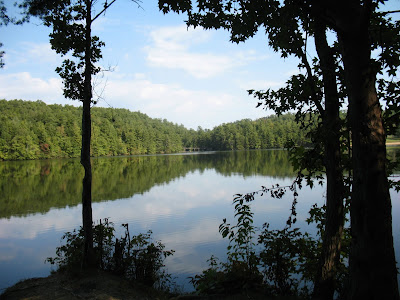Indian Boundary Recreational Area in Cherokee National Forest is a wonderful campground. The amenities include hiking, fishing, kayaking/paddle-boarding, biking, swimming at the sandy beach area.
We were pleased that as first-timers we had no trouble setting up.
Our site was located in a perfect spot: shady all day, peaceful and very spacious. Oh, and near the bathhouse!
After our restful night's sleep, Chris prepared breakfast over an open fire. Yummy! Then we headed out in the cool of the morning to hike the 3.6 miles around the lake.
I was looking forward to seeing the large cypress trees along the edge of the lake. Notice the cypress knees protruding from the water.
The foliage on the cypress is feathery. An interesting feature of the cypress is that the "leaves" or needles turn yellow and then brown in the fall. They eventually drop off like deciduous trees' leaves.
The lake's water was as still as glass.
Across the lake we could see the dam and the long beach area. Few people had ventured out at this time. Later the beach area would be a hive of activity!
Although most people think that spring is the best time to see wildflowers, the fall offers a different color palette of blooms, berries and fruit.
Beech drops (Epifagus virginiana) were scattered thick under the beech tree just off the trail. Beechdrops, a parasitic plant which derives its nourishment from the roots of its host beech tree, are easy to overlook because their blooms are not showy and they blend in with the leaf litter.
Cowbane's name indicates its properties. Although it's in the Carrot/Parsley family, the leaves and roots are poisonous to cattle, thus its name Cow Bane (Oxypolis rigidor).
A plant that blooms in the spring with nondescript flowers puts on a show in the late summer/early fall with its seed capsule popping open to reveal bright red seeds. Look closely and you can see why Euonymus americanus is frequently called Hearts-a-Bustin'.
We just happened upon this tiny spent orchid, Autumn coralroot (Corallorhiza odontorhiza). If a sun ray hadn't spotlighted it, we would have missed it. Look closely at the brown stalk in front of the ground cedar (Diphasiastrum digitatum). This bloom of this tiny orchid actually doesn't open.
We liked the tree that I named the Three Sisters.
Gentians bloom from mid-August until frost. Look inside the bloom to see the bee guides. Bumble bees are the typical pollinator.
Gentiana decora is also known as Showy Gentian because of its lovely pale sky blue color and darker stripes.
Close by the Gentian was a full cluster of Turtleheads (Chelone glabra). As you can see, this plant is aptly named. Each blossom resembles a turtle's head. I especially enjoy finding the white or blush color of Turtleheads.
Lobelias are a lovely flower common in woods and along roadsides and streams. Downy lobelia (Lobelia puberula) resembles a cute dancing angel dressed in lavender.
A surprise awaited us along the edge of the trail: Spiranthes ovalis! These Ladies tresses are woodland orchids that grow up to 18" with an inflorescence 1"-4" with the braided pattern spiraling up the stem. All the Oval Ladies' Tresses I've encountered have been much shorter with a short inflorescence.
I was pleased to find several of these delicate orchids scattered beside the trail.
This shot gives a clear view of the lady's braids!
After lunch we hopped in the Xterra to head up the Cherohala Skyway to explore. The late summer flowers were gloriously arrayed! Rich purples, dark blues, golden plumes created giant bouquets of color! We wanted to check on the status of another variety of Ladies' tresses that grows at higher elevations.
Nodding Ladies' Tresses (Spiranthes cernua) grow in abundance in an area just past the NC state line. I'm pleased that the Forest Service has posted NO MOWING/SPRAYING signs along this stretch.
Late summer is the time to see the asters display God's glory! New England Aster is a majestic flower sometimes reaching 5 feet high. The tall Goldenrod and blue sky provide the perfect backdrop for nature's landscape.
Tiny clusters of the Calico aster dot the roadside.
Butterflies and bees are busy storing up for the coming winter.
Great Blue Lobelia grows in abundance along the Cherohala Skyway.

 I was
I was thoroughly amazed and delighted to find hybrids of this majestic flower growing in a meadow near the Whigg Meadow trailhead. The typical deep dark blue blooms caught my eye as we were driving along the Skyway. After closer inspection I discovered that the colors varied from the darkest purple-blue to pale lavender. The white parent was across the road. Unfortunately it was nearly spent. I wish I had seen the bloom cluster at peak!
But the offspring were fun to photograph and study.
What an amazing experience! Camping in comfort in our "tiny house" and exploring an area of the Cherokee National Forest.














































No comments:
Post a Comment